Residents Push MTA for Upgrades at Fourth Avenue Station

The Idea
“I wanted to see Fourth Avenue as a connector among neighborhoods.”
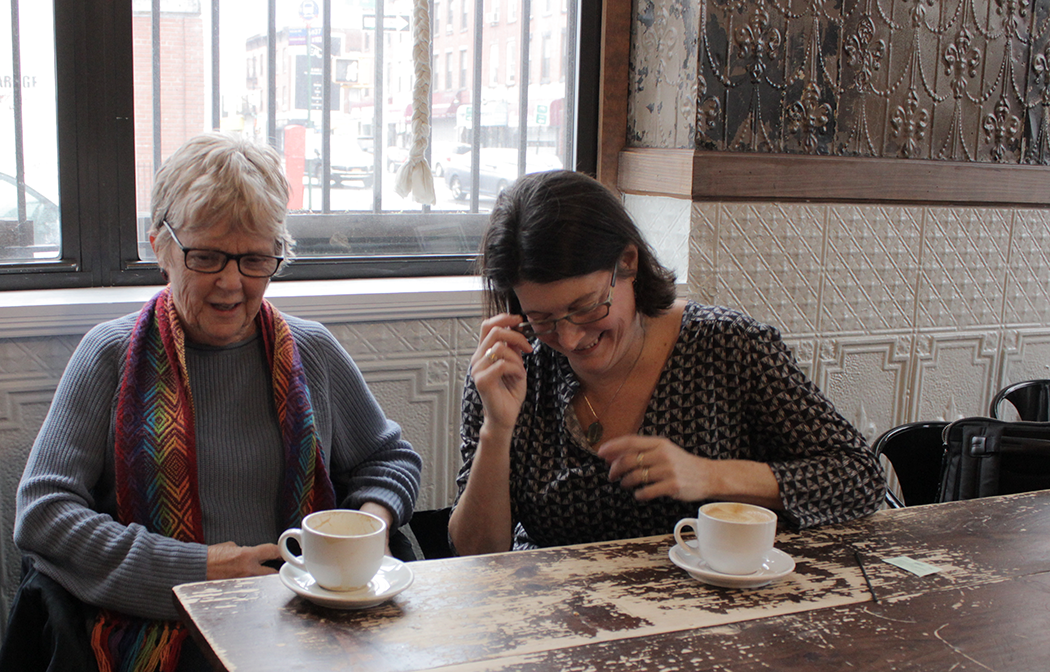
Grace Freedman: I live between Third and Fourth Avenue. I've lived there about twenty-five years and I've been involved in Fourth on Fourth Avenue and Park Slope’s Civic Council for maybe four or five years.
I wanted to see Fourth Avenue as a connector among neighborhoods. I personally traveled to Park Slope and Cobble Hill, Fort Greene, Gowanus, but I felt like there wasn't a lot of dialogue among the different people in those communities.
Fourth Avenue was sort of this big highway and a divider. But you know, once I met with SJ and some other community groups, I thought this could be a way that we can bring some of the diverse interests and neighbors who live between Third and Fourth and between Fourth and Fifth to know Fourth Avenue better — more livable, greener, safer in terms of traffic safety and other things. So that was my personal driving force and I found a lot of other like-minded people on Fourth Avenue.
SJ Avery: Part of our perception of what had been a problem with Fourth was that everybody looked at it as a border. So if it's a border, it doesn't belong to anybody, and we wanted to get a better sense of belonging. The MTA wouldn't even respond to [City Councilmember] Brad Lander’s questions about when [improvements were] going to be done, and he was getting fairly indignant about it.
Making It Happen

Freedman: We wanted to make it fun and have some hands-on demonstration, so we had a couple of workshops where people made cardboard props. We put up canvas and the idea was we would cover all the eight spaces with storefronts and just try to make it fun and enliven it.
We also we told the MTA we were going to do this because we're part of the Park Slope Civic Council. We weren't going to do this like a stealth event. We decided that the whole point is to engage community awareness and our end goal was to get a meeting with the MTA so they update the community on what the status of [improvements were] and take some feedback from the community on simple low cost fixes or hear what the community thought was important at that station.
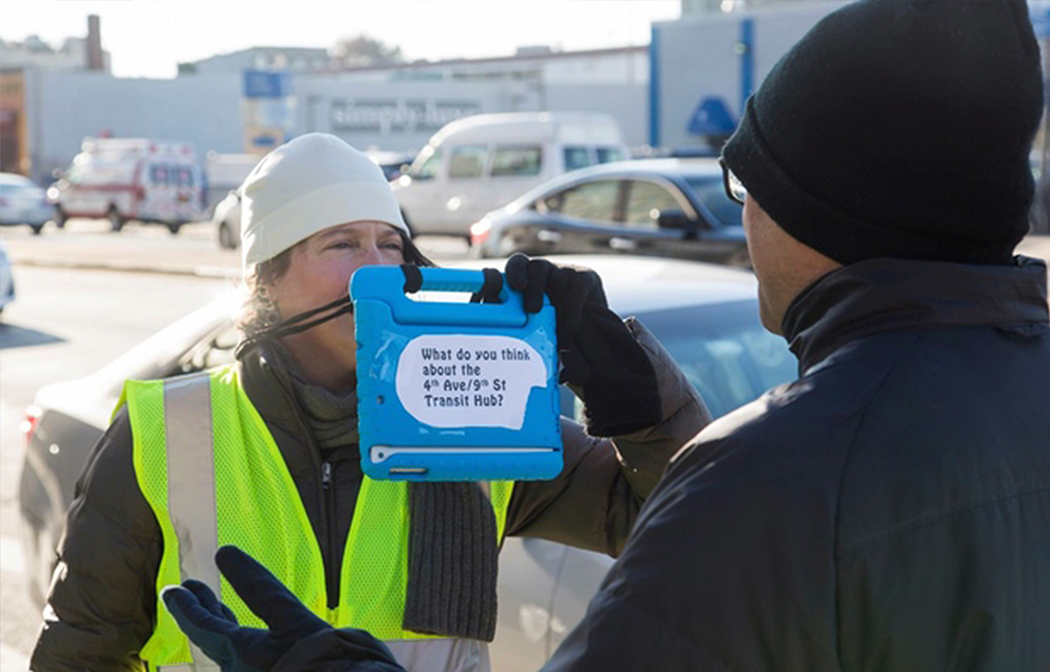
The MTA got upset
Freedman: We talked to the local police precinct, they were behind us. They were like “As long as you don't use electricity or amplified music, we have no problem.” And Brad Lander’s office was behind us. So we're like “Well, we're just going to go through it anyway.” So about two or three days or maybe a week before the date we get a call [from the MTA]. Again remember, this is something that has been years and years overdue. None of the elected officials could even get a peep about what the schedule was and what was happening.
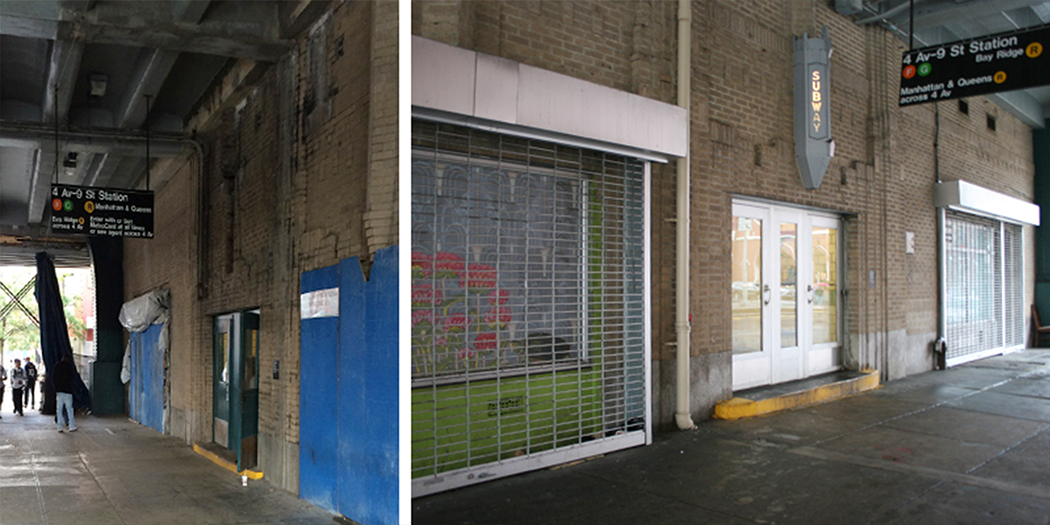
So a handful of days before our demonstrations, we get a call from the MTA that “the scaffolding is coming down on the day of your demonstration and for any extra people to be at the station would be a serious threat to public safety,” and if we were there, we should expect the authorities. So we had to decide what we were going to do. We had to decide, “Are we going just going to show up and get arrested with our cardboard props or what?”
“We used it as a bargaining chip.”
Avery: When we said we would move, we used it as a bargaining chip. “We'll move our demonstration if you commit to having a public meeting with the Park Slope Civic Council and addressing our concerns and giving us a schedule.”
Freedman: Thankfully we had a partner in The Old Stone House, a public park that's a couple of blocks away from the station. They said, “You can set up your your fantasy station here.” So we set up the props [and] we still invited the press. We still invited the politicians. We had maybe twenty or twenty five hearty souls, because it was a very cold day. We still did it!
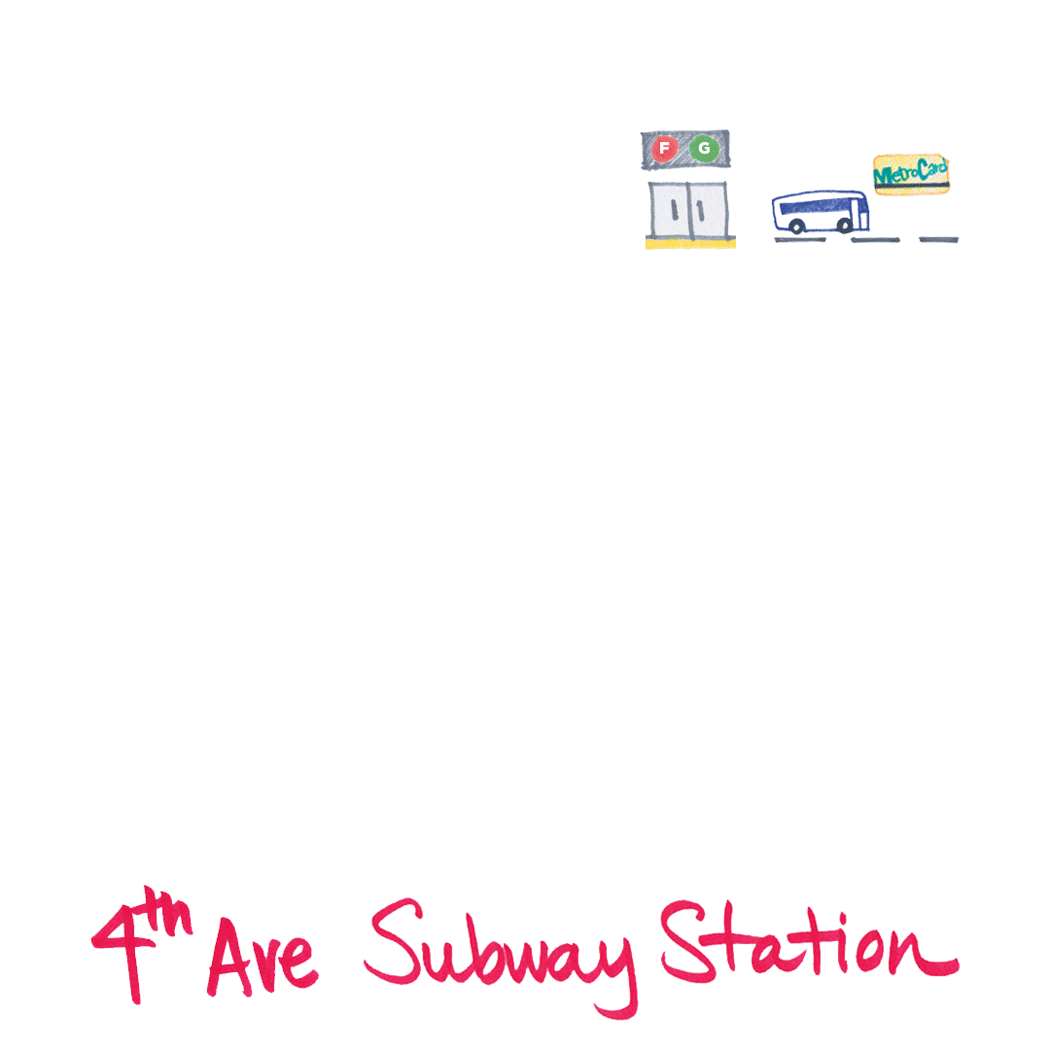
Lessons Learned
“Persistence is a huge part of it.”
Avery: What brought people to the events were one-on-one requests and telephone calls. I think that gets overlooked. Sometimes in terms of organizing today, there's a sense “Well, if I put it out on Facebook, a thousand people will come” and you know for the Women's March, certainly social media was absolutely terrific. But what happened behind that, the reason so many people came out, is that people created their own affinity groups and started talking about it with other people. When you're working on a smaller level, the ability to call Bernice or call Kathy or talk about it at your book club meeting and say, “We're going to do this fun thing, I think you might get into it,” that’s real important. That hands-on, person-to-person organizing. I don’t think it can be understated.
“It's much easier to go back and say 'Hey you committed to this. What's the status?'”
I don't want to say it's easier but that's the core of accountability, when you've made a public statement, you've written a public statement or said something in a public meeting. It's much easier to go back and say “Hey you committed to this. What's the status?” We understand, especially with government, things can take a really long time. But to make sure that our elected officials or people who are investing in the community realize there are people paying attention or listening and we'll follow up and we'll hold you to your promises.
CORRECTION: An earlier version of this article incorrectly identified SJ Avery as "Susan Avery". She goes by SJ Avery. The text was updated at 11:00 a.m., April 24, 2017. The audio was updated at 4:30 p.m., April 24, 2017.

NYC’s First Community Garden

The Idea
“We took some space that the city thought was derelict...We planted it and we made it a place...people can use.”
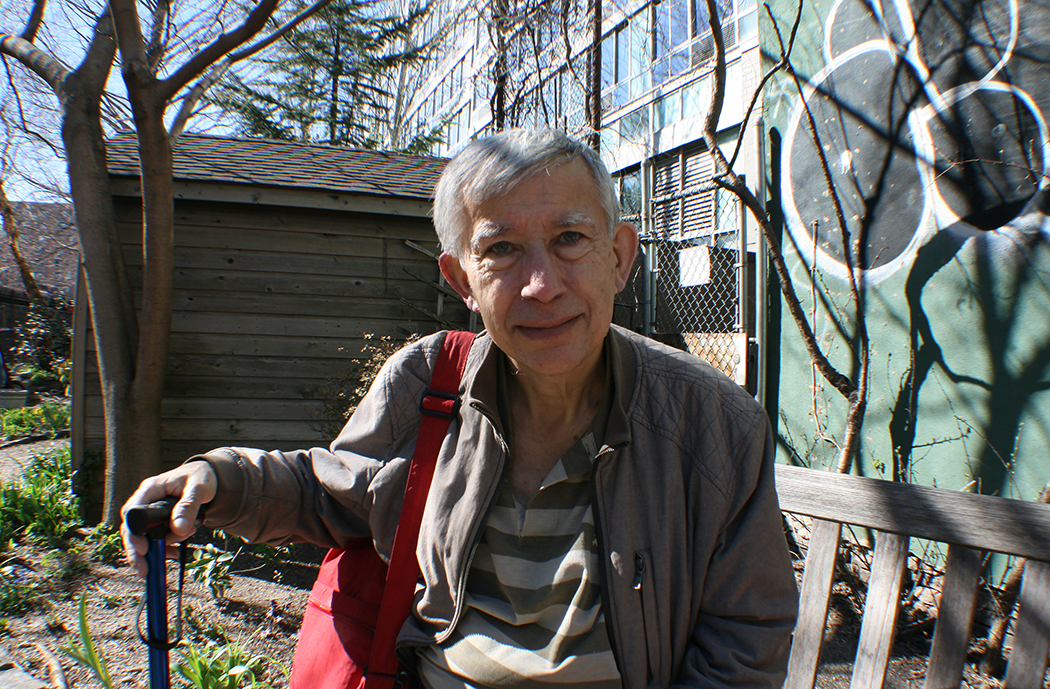
In 1973, the area around Houston Street between the Bowery and Second Avenue was run down. People struggling with addiction became fond of hanging out at a vacant lot on the north side of the street.
The city was facing a fiscal crisis and didn’t much notice the lot. Some area landlords had abandoned their properties. Burnt out buildings were common in the neighborhood. Plus, the neighborhood lacked park or green space, and the city did not want to shell out money for upkeep of a garden.
The low rents also attracted younger people, many Latino or Asian. They didn’t like that the lot was full of vagrants. Plus, the neighborhood lacked park or green space, and the city did not want to shell out money for upkeep of a garden.
To counter this bleakness, area resident Liz Christy took matters into her own hands. She got some dirt for the lot, put a spade in the ground and started planting vegetables and flowers. She coaxed a group of locals to join her in greening the vacant lot.
She also started throwing seed bombs — balls of flower seeds — into multiple lots in the East Village and beyond.
“Liz was a tremendous promoter and a good motivator. She could get people to do things, and she worked very hard.”
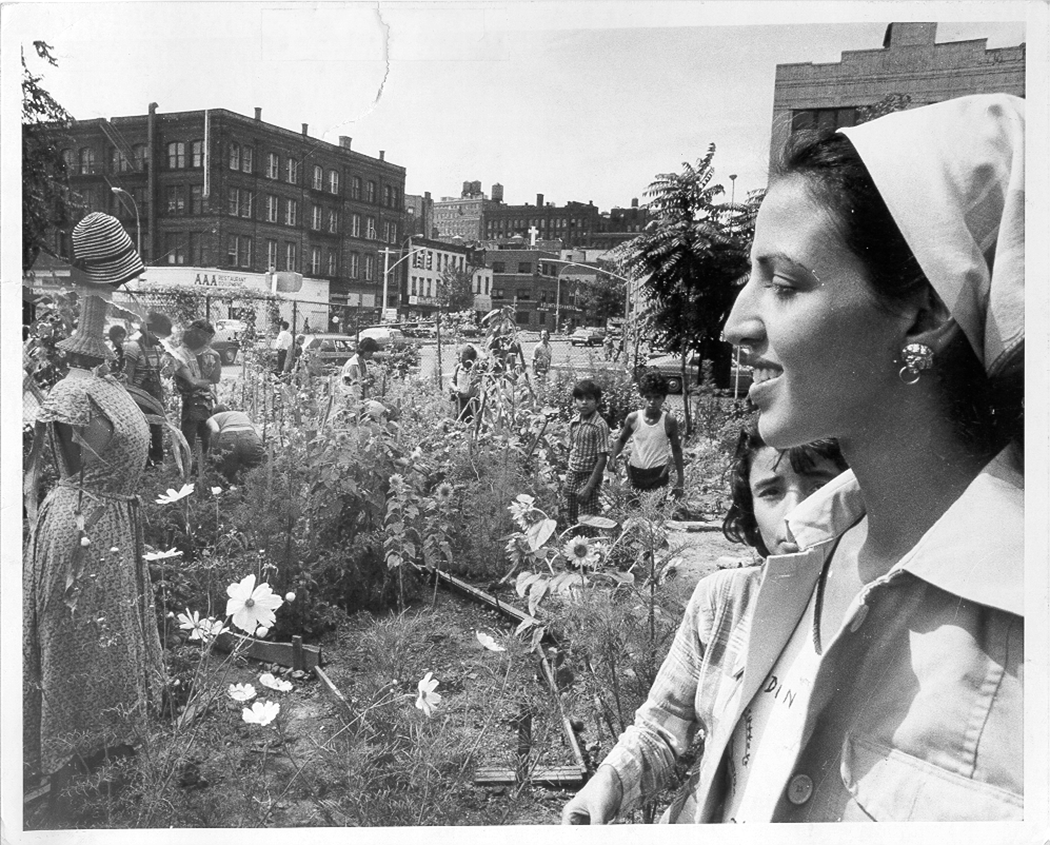
Gardener Bill Brunson was one of the founding members of the garden. He remembers Christy as wanting to green all parts of the city, from median strips to planting in the subway. The group named themselves the Radical Rhizomes, spreading a gospel of green through the neighborhood.
They later changed the group’s name to the Green Guerillas, and worked with other community gardens to facilitate plantings and help new groups establish themselves in the model of the Houston Street garden.
Making It Happen

“They could have gone out and raised a bunch of money… Instead, they said what can we do with cutting donations from nurseries and vegetable clippings from the bodega.”
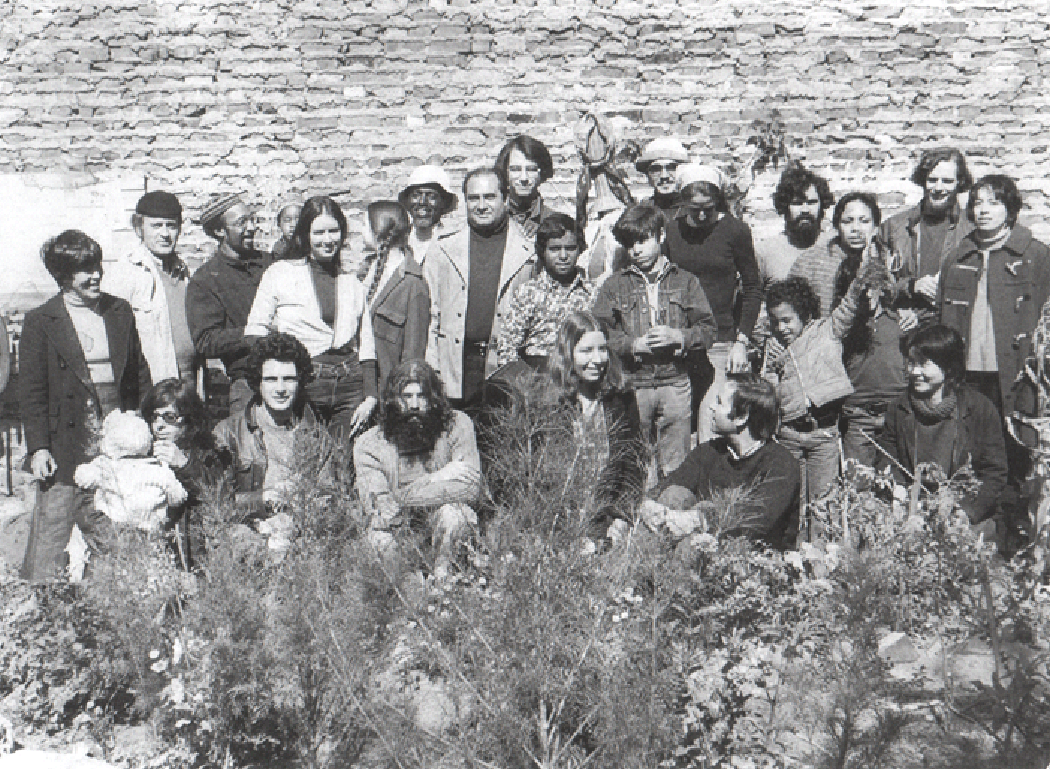
For the first year, the gardeners worked under the radar, mostly at the vacant Houston Street lot, planting flowers and herbs. The city didn’t notice the garden until the following spring.
Founding member Don Loggins said Mayor’s office threatened to bulldoze the greenery and kick the gardeners out. But Christy organized an offensive. She called the media and told the garden’s story.
That led to a compromise and official recognition from the city. It offered the garden a lease for a dollar a year. Christy succeeded in using grassroots organizing to save the garden and create new green space. She transformed gardening into a political act.
Other communities saw the success of the plot on Houston Street and began demanding the city designate open space on their vacant lots. Each new garden was a bit different, tailored to the specific wants and needs of the area, but modeled on the Liz Christy Garden.
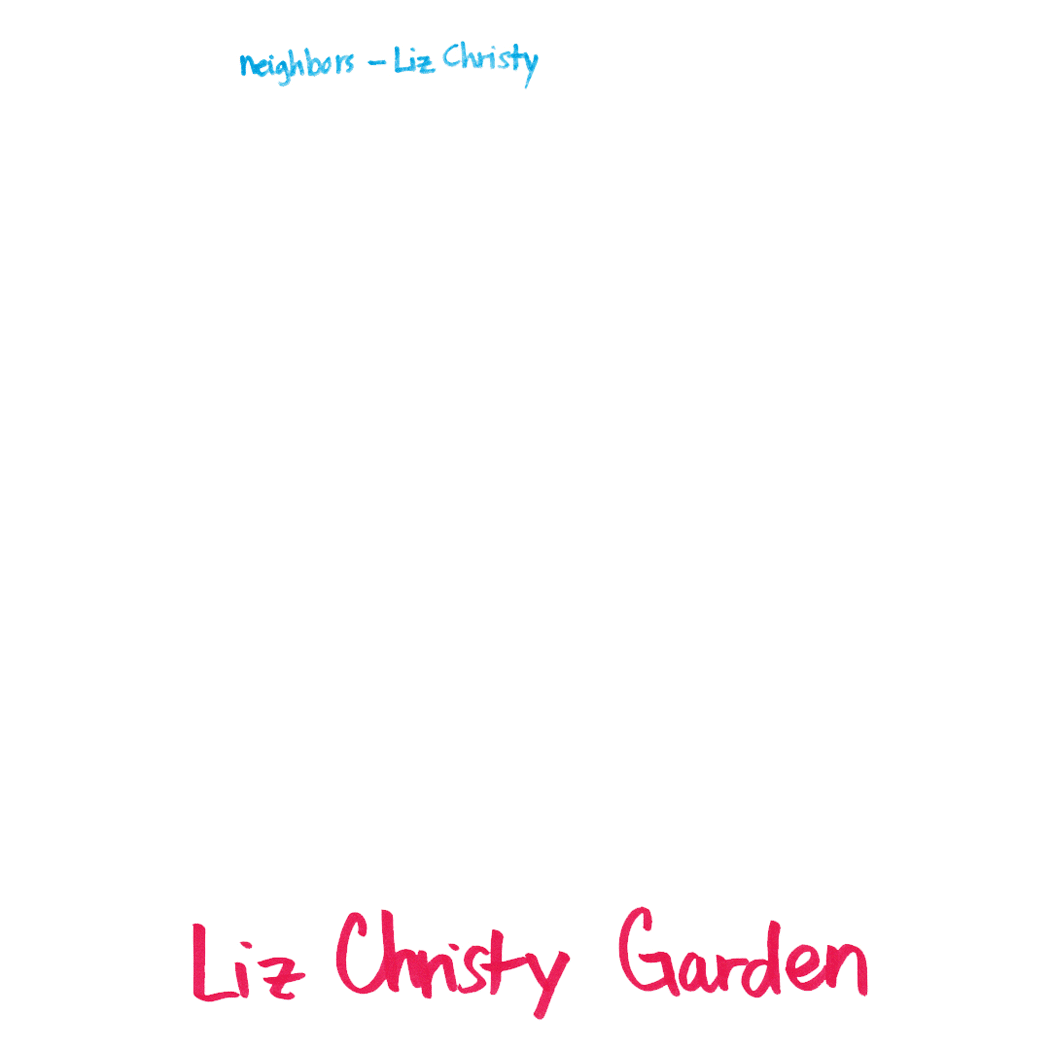
Lessons Learned
“The law could change and all of a sudden this could not be here. And so people have to take an interest in it and stand up when it’s under threat.”
The lesson learned from four decades of garden activism is that communities still must stay vigilant to actively protect their green space.
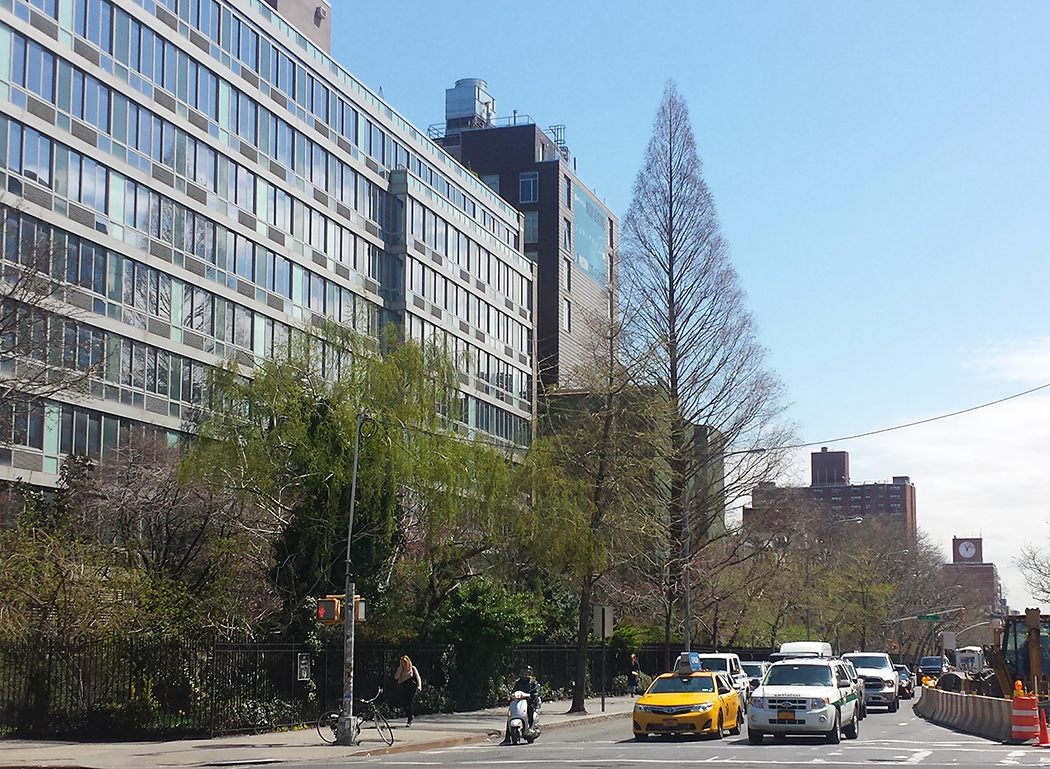
As the value of land has risen in New York City, community gardens have faced enormous pressure. Even affordable housing proponents eye gardens as the last bits of viable open land that could be turned into rent stabilized apartments.
In the mid-1990s, Mayor Rudy Giuliani proposed auctioning off more than 100 gardens to the highest bidder. An additional 600 were at risk of being transformed into developed sites.
But Giuliani’s plan stalled. In 2002 a compromise was brokered by a new mayoral administration. Mayor Michael Bloomberg and Attorney General Eliot Spitzer announced a plan to protect about 500 community gardens, while also proceeding with 2,000 units of affordable housing at 153 different sites throughout the five boroughs.
The agreement also established a review process for future proposals to develop garden properties: it ensured that existing gardens are considered in city land use decisions.
But the threats to local gardens continued, even touching the Liz Christy Garden.
A nearby residential development proposed a number of changes, including a walkway that would have sliced the garden in half.
The gardeners initiated a grassroots campaign to save the land. They wrote letters, circulated a petition and made speeches to community boards. Again, it worked. The city supported the volunteer gardeners as they negotiated with the developer. In a compromise, the garden’s space increased by a bit, and the developer contributed to the garden’s plant budget. But the garden did have to close its gates for two years during construction. It reopened in 2006.
After another tug of war between gardens and housing in 2015, the de Blasio administration made 34 community gardens permanent, while some were set aside for affordable housing.
In all there are still more than 550 community gardens in New York City, though gardeners will tell you, it’s important to remember that at one time, there were more than 800 community run green plots in the city.

Caracol Interpreters Cooperative: Bridging Language Barriers

The Idea
“Language justice puts all people in the position where they can fully participate and bring their whole selves.”
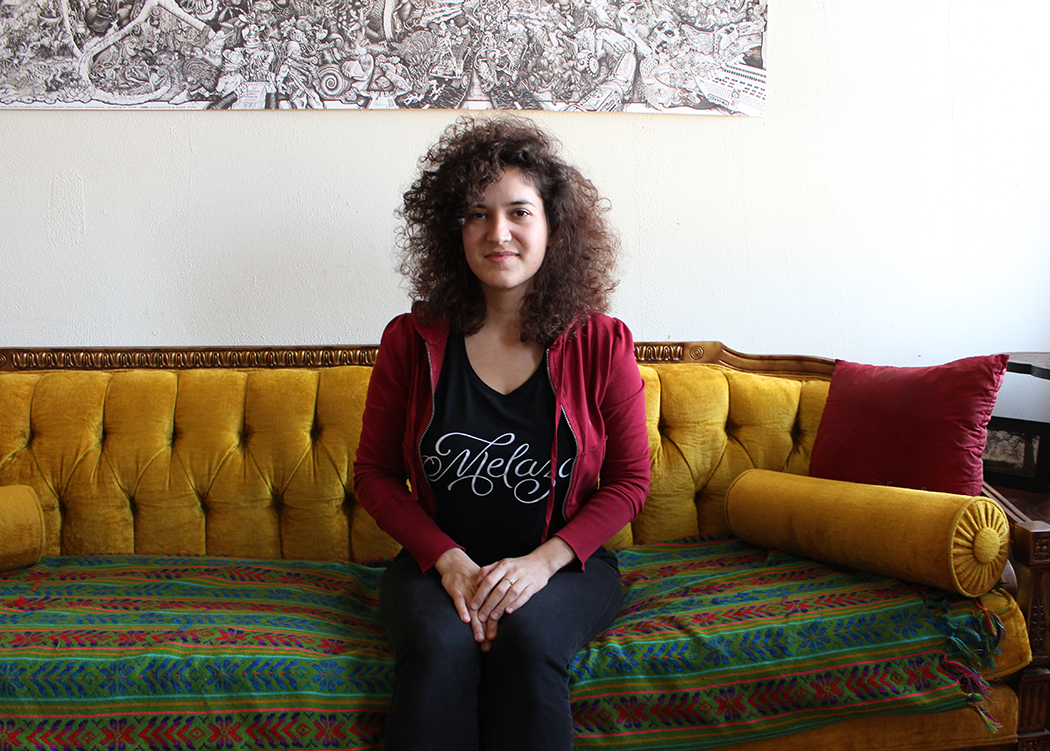
Ramírez: Caracol Interpreters Cooperative is a small, worker-owned business that is lead and run primarily by immigrant women. We offer high quality language services in English and Spanish. These include interpretation, translation, interpreter trainings and consulting for organizations that want to build their multilingual capacity.
Some of the topics of the meetings that we work are housing, education, workers' rights, financial literacy, and community organizing meetings.
The issue with language services or language access is that it is formulated from a position of power, right? So you have the city for example implementing guidelines and policy around language access, but they come from top down. Or you have people talking about why language access is important. Well access is accessible to you, but that doesn’t allow you to be empowered necessarily, it doesn’t put you on equal playing field. So the way that we practice this work is around justice.
Being a bilingual person, I have experienced through my life that role [of being an interpreter] informally, and I was involved in activism and movement work. I started volunteering and I noticed slowly that I started incorporating principles of language justice in other work that I did. I never thought initially that I would end up doing it as what I do every day.
When you're talking about issues of criminalization, housing, access to healthcare, there is a huge racial and ethnic disparity. A lot of that also has to do with language based on who are immigrants in this country, [who] belong to marginalized communities, and [who] have intersections of identities that further push them to the sides.
The work that I was doing and how I was involved made me realize that there was race and ethnic disparities but there was also a whole other level with the language piece.
Making It Happen
“Everyone must be in the process of participating in establishing the multilingual space.”
Ramírez: A lot of what we do has to do with making sure that everything that will be printed and handed out is in both languages that the meeting [is] held in. Then it will be to make sure that the setup is also conducive to allowing for anything that happens in the space to also be done in both languages. So if people are going to be writing down ideas as a brainstorm on a board, to make sure that board has space to write both in Spanish and English. If there's a PowerPoint, to make sure that PowerPoint is in both languages. And also if there are any other audiovisual materials, those materials are assessed for translations, or given to the interpreters beforehand, so they can study and make sure that they're prepared to interpret simultaneously for them.
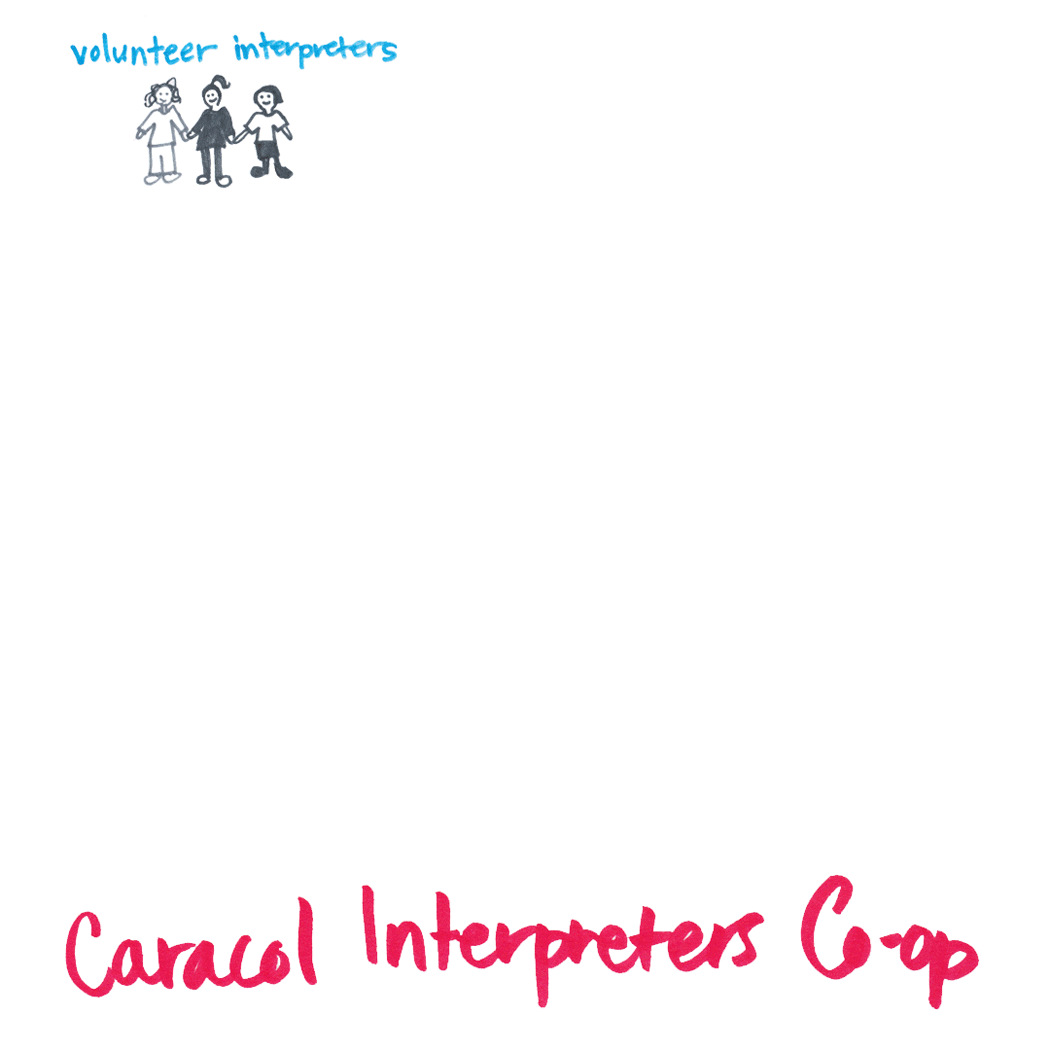
Wearing a Headset
Ramírez: We start giving out equipment as people start arriving. We don't ask folks “Oh, you only speak Spanish?” or “You only speak English?” because we we don't want to single out people. We let people self-assess, but we explain, if they're not sure, “Well how is your English? Do you think you can understand the full meeting? Would you like to take it just in case?”
We want to make sure that we educate people to know that they shouldn’t miss out on information or what is going on in the meeting because they feel shame.
Something that I do as an interpreter, sometimes to make people more comfortable is I wear the set, so people also know that I also might want to hear my partner, or I also want to hear the interpretation.
Using Hand Signals
Ramírez: We work with some hand signals. And those hand signals help the interpreters and the room be able to stay on track in terms of understanding each other. Some of the hand signals that we use, one of them is for folks to slow down a little bit and keep a pace. People should be speaking at a pace that is not too fast. Another hand signal that we use is to show that they need to speak up.
The other rule that’s very important is one mic. So only one person can speak at a time, not only because it’s a general ground rule, but also because an interpreter can’t interpret two people at the same time. We have a hand signal where we ask folks to repeat something. It usually just means “Repeat the last bit,” that we didn’t catch it. We try not to, but sometimes it does happen. Our [interpreters] are from a good chunk of countries and backgrounds in New York, [and] different parts of the United States. Between all of us we have a big pool of words and terms and different slang that we can negotiate.
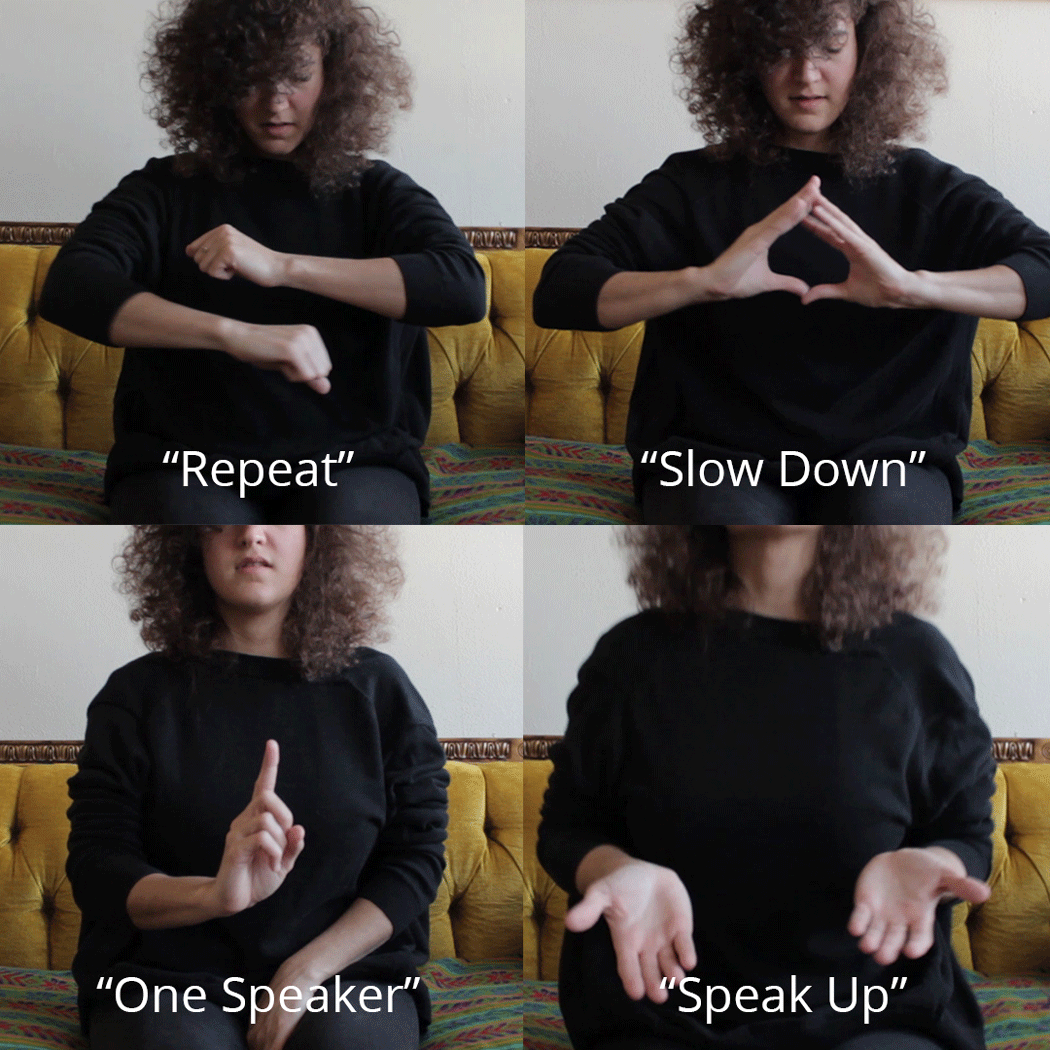
Lessons Learned
“When you get past the language part, that's when you actually start building.”
Adapt to Your Audience
Ramírez: We have to adapt to the audience. Some things will look different, some things are just general. We need to make sure that we're using the words that make sense with the context and are most appropriate for the theme or the subject.
Caracol is the only language justice co-op in the city right now. There are networks of folks that are also community interpreters for Arabic, South Asian languages, Mandarin, Cantonese, Fujianese.
Caracol only does Spanish and English, but because of our work and broader movements, we are connected to interpreters and organizations that also interpret into other languages. Some of them are Nepali, Tagalog, Urdu, Portuguese, Haitian, Creole. They are not part of our co-op but we know how to find them, and if we are working an event or a gathering that incorporates those languages, we collaborate with them.
Best Practices
Ramírez: We try to stay on top of terms and make sure that we're always open to and not being resistant about language because language is fluid. We also want to say things properly, but we also have to be open, especially right now in this country, how language is mixed and in flux.
You have to say it all, even if you don't agree and even if it's something that hurts you to say as an interpreter. [You have to have] good buddies and other good interpreters that you can [talk to] and sometimes do a little bit of the healing work because this work can also take a toll on you in terms of the kind of stuff and conflict that you are interpreting.
I think we're in a place where we can't have separate people in separate rooms anymore. We need to make an effort to have folks that usually wouldn't be in that room together to actually be in that room and when you get past the language part that's when you actually start building. The discomfort, the misunderstanding, once you get folks in that room and you don't have to worry about the language piece, about them understanding each other, then you start doing the work, and that is where the actual possibility of deep transformation, I think, can happen in a way that the current political climate needs.

Participatory Budgeting: The People’s Budget

The Idea
“The people's budget is an opportunity for community residents to decide how a million dollars or more is spent in their community.”
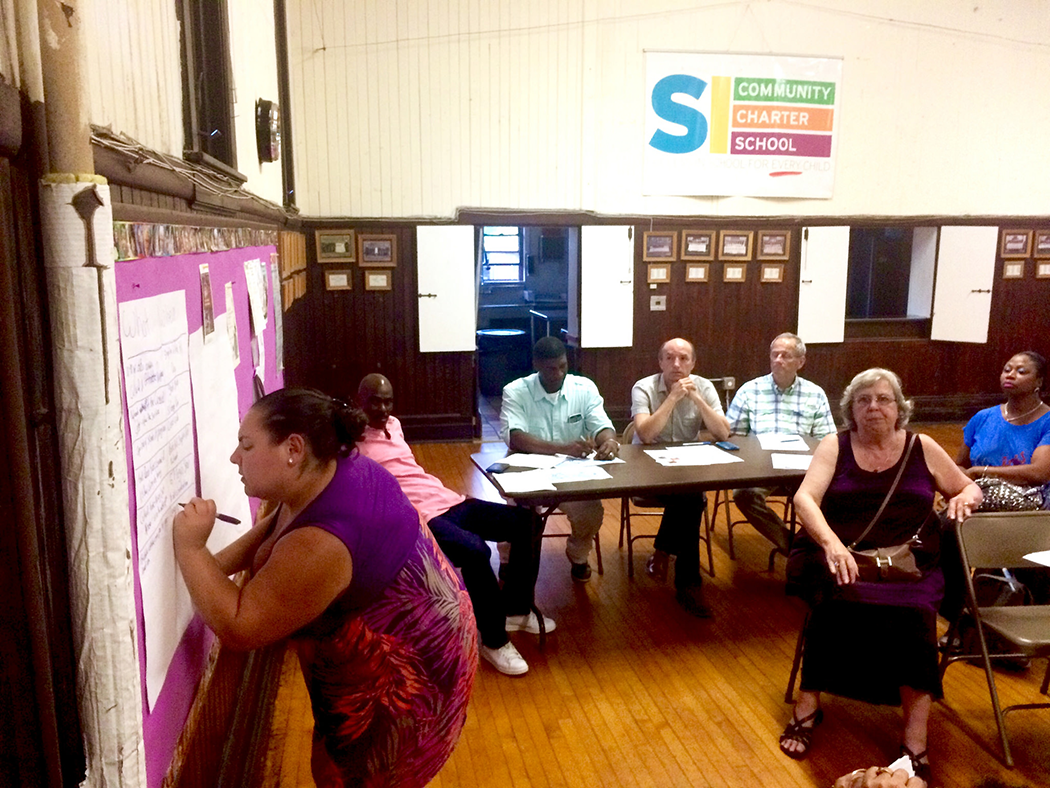
Aaron Jones, Community Voices Heard: We discovered PB [participatory budgeting] at the World Social Forum in Brazil, which is where PB started. At first, our intention was to have it as a PB process in NYCHA, that is our base. It really gets at the heart of low-income New Yorkers being able to have a say in how to better their developments. It didn’t happen — it landed in City Council with four City Council members each putting one million of their discretionary funds into the process. We’ve sort of been ushering in this process each cycle as it grows, mainly playing the lead organization for community engagement.
In the beginning we more so did any and everything for the process when it was outside of government, from drafting the materials to helping establish the steering committee, to thinking of the outreach plan. As the process has been institutionalized and we ushered that in, we have been consulting, helping to educate, inform.
Debi Rose, City Councilwoman from Staten Island: It’s the first time we were able to engage North Shore residents in the budget process. So this is a celebration of democracy at its best. And my hope is that not only did they have input in projects that should or they’d like to see funded, but it would also open their eyes to what the budget process is in New York City.
Jones: Council member Rose has made PB truly a five borough process now. Ideally, really we'd like a city-wide process, where more money is being determined through this process. So yes, right now, we are 31 council districts. Hopefully, one day we’ll be at a citywide process where it won't be an opt-in, but really everyone can participate. It’s an opt-in process, each council member decides on their own to participate or not.
Making It Happen

Rose: I thought we were missing an opportunity to educate people. I saw how people didn't understand how important their voice and vote was. I was looking for a way to get them engaged in the process and so what better way to engage them than for them to have to conceptualize an idea they want funded and then have to come out and support it and get people to come out and vote for it. Only the projects with the most number of votes will be the ones that win.
There are 8 projects. The ones with the top number of votes, will definitely be funded. And if there is some balance in terms of the money, another project with the next highest number of votes will be chosen.
Part of the process was, once they came up with the concept of what they wanted, it was then forwarded to the appropriate city agency to be vetted and to come up with the cost, because they know what the actual cost to make these projects would be.
Sarah Kawaling, Budget Delegate: [Project ideas] came from the needs of the community, for example we have a basketball court that’s located outside the community center where we are located. The floors are cracked, the rims are bent and the whole community uses this through the year, so it would be great to have it covered because they could use it rain, sleet, snow, all types of weather.
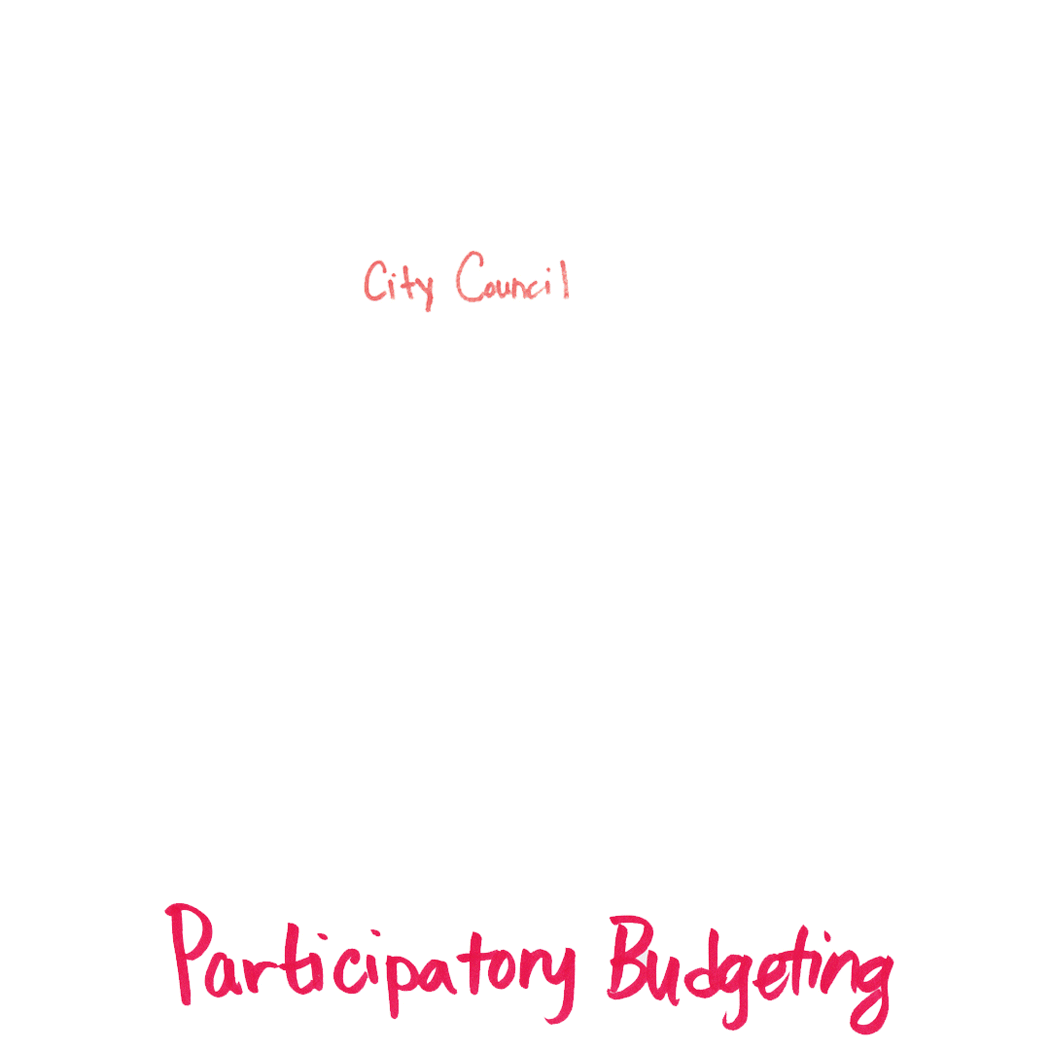
Not Taking Care of All Community Needs
Kawaling: When we started with the committee, we had several meetings with NYCHA representatives. So we had some other projects that came on the board: a garden, doors, sidewalk renovation, but those are different departments. The community definitely has need for many, many other things.
Jamar Brunson, Budget Delegate: It’s a competition where there’s only 1 million dollars and everybody has to share that million dollars. These projects are not cheap. Some of these projects are 400-, 450-thousand dollars and we only have a certain amount left over. This is where I live at, this is where my family lives at. I’ve been living here seven years and these are some of the things that should have been accomplished in those seven years. I proposed lights and the basketball court, also a removable stage. So when anybody comes out here to speak we have a stage for them to stand on.
Clara Ogburn, Resident: There’s just so much. Technically, it’s a shame we have to limit it because of the budget, because the budget should encompass all of the items that are main concern that are listed here.

Lessons Learned
“Those who actually see the process through, they are more engaged the next cycle and commit even deeper.”
Rose: We were overwhelmed. The response was really eye-opening. It was exciting to see what people in my district wanted to be funded. Some of the things that they wanted to see funded that were not able to be funded through this project are things I might be able to fund out of my capital project budget. It opened my eyes to some of the things the community thought was important.
Jones: I’ve had a good reception. Of course there are people who are skeptical or need to see the process through. But generally everyone is receptive to it. There are sometimes they joke “Oh a million dollars, it's coming to me?” But then those who actually see the process, they are more engaged the next cycle, and commit even deeper.
NOTE:The winning projects were announced by City Councilwoman Debi Rose’s office on Wednesday, April 26, 2017 at Brighton Heights Reformed Church on Staten Island. New technology equipment at six North Shore schools and adult exercise equipment at Clove Lakes Park will be funded.

Allergic to Salad: Learning to Cook Healthy Food

The Idea
“If you never give people a chance to eat anything else, of course they'll never eat anything else.”
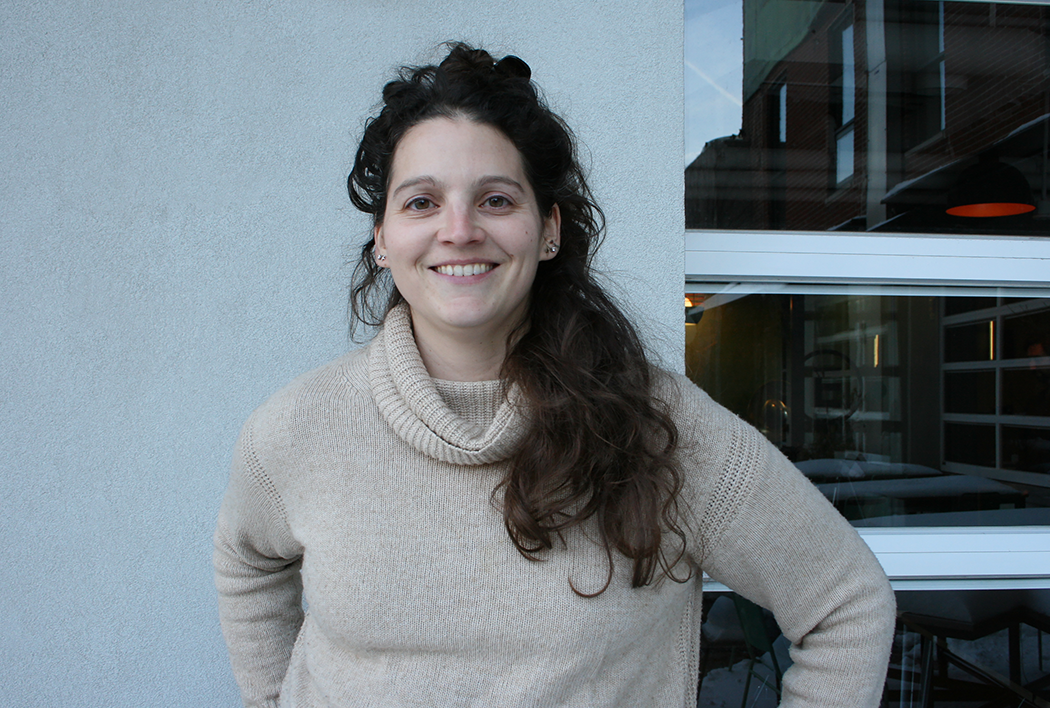
Ornstein: I am the founder and director of Allergic to Salad, a youth-based culinary program. I was working for a couple of nonprofits. One of my tasks at this nonprofit was that I was in charge of ordering lunch for high school students and it was always pizza or hamburgers, pizza or hamburgers.
I said, “Can't we just order sandwiches or just anything other than pizza or hamburgers?” and the response that I got was, “Why even bother? They're not going to eat it.” And I thought that was just really catering to the lowest common denominator of “Well, if you never give people a chance to eat anything else, of course they'll never eat anything else” so that was sort of my aha moment.
Allergic to Salad started [when] I was doing it myself, just freelance teaching in after school programs, teaching cooking. It came about because I lived in Astoria and I had local parents who...were like, “Why are you doing programming around the city and not where you live?”
I'm sort of the kind of person that if somebody challenges me to do something, I will take on that challenge. So that's when I started doing classes locally in Astoria.
Making It Happen

Ornstein: I would find a restaurant that wanted to host a kids' cooking class. The restaurant would partner with us and I would basically fill it and advertise. Why would a restaurant give a free cooking class and then on top of that pay for the food for that cooking class and then give back a donation to a children's culinary nonprofit? The incentives were, one, that you have all of this very positive local feedback. We had literally hundreds of parents that were talking about this restaurant now and saying “When are you doing another one?” So I think [the classes are] really good karma for the restaurant.
Before it used to be that the fundraisers sort of paid for themselves. Now what we do is the money that's raised during those restaurant partnerships goes to purchasing equipment that we use in our public school classes.
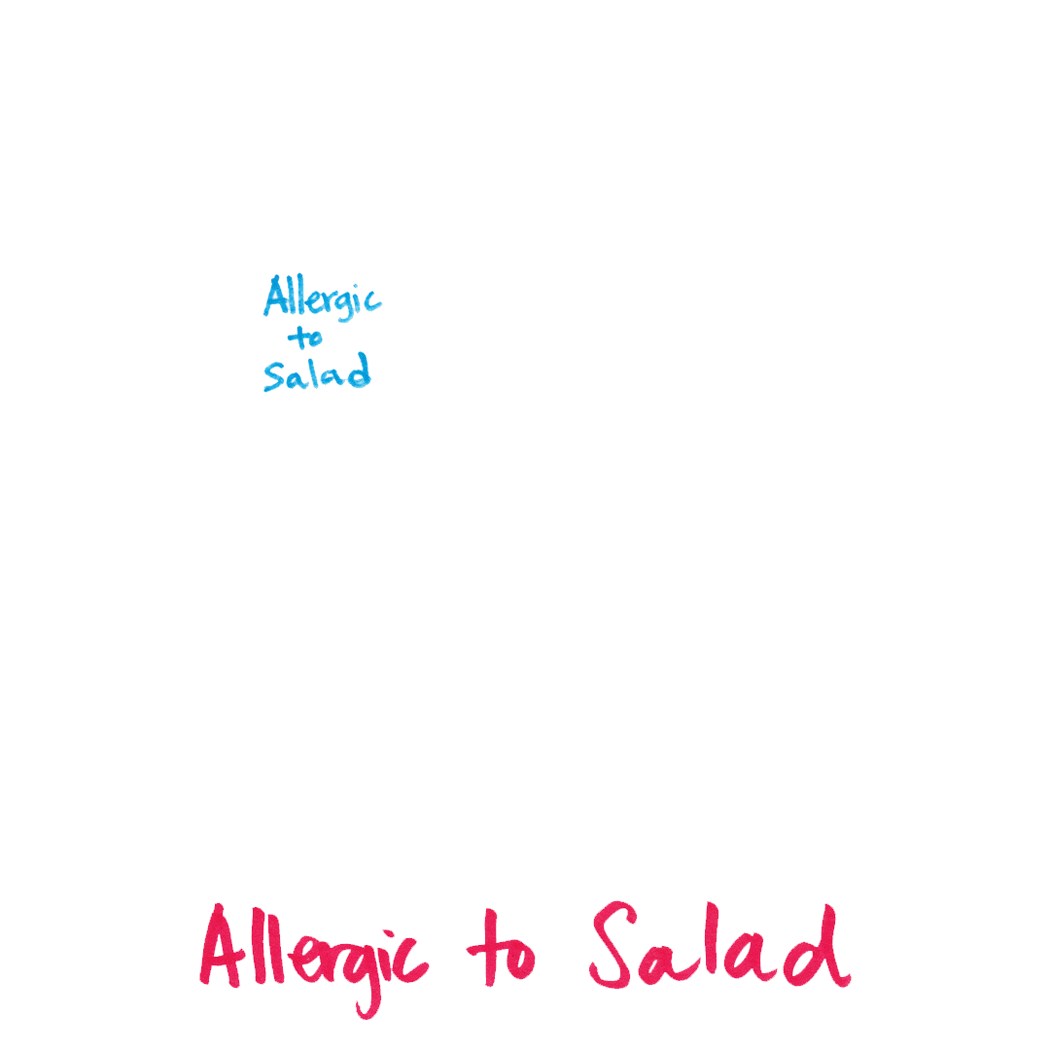
"My child won't listen to me."
Ornstein: Some of the biggest feedback that I get with my classes is from parents who are like “My children doesn't eat any vegetables but you get them to eat vegetables in class and so how do you do that?” It's like you're not there as a parent, so your child is willing to try more and do more and it's especially successful with cooking.
I stay away from the word “picky.” If a parent drops off a child and they say “Good luck with this one because she's a picky eater,” that's the worst thing you can ever say because I didn't know she was a picky eater. She knew that I didn't know that she was a picky eater, so now by saying that, you've just given her the out that if she thinks that what we're cooking looks a little strange or is unfamiliar, now she doesn't have to try it. Whereas if you don't label it, you can have a lot more leeway and adventurous eating with the students and with kids in general.

Remaining positive in the classroom
Ornstein: I think a lot of it is remaining really positive in the classroom. It's about letting them explore and letting them taste while they're making all this. I think seeing the components of how something is made is much different than just getting the final product. I think children just naturally want to explore these things and sort of pull things apart.
“Usually in class, we joke that the first rule of the kitchen is try everything, and the second rule is you don't have to like it.”
I have some students in my class who will taste every single component of the dish while we're prepping it, but then the final dish comes [and] all of a sudden they don't want to try it. Usually in class, we joke that the first rule of the kitchen is try everything, and the second rule is you don't have to like it. We really try to abide by that but ultimately if someone really can't handle the first rule of the kitchen, we're not going to force anyone to, but usually a student will come around, even if they just try to lick it or smell it.

Lessons Learned
“I grabbed it and ran with it.”
Ornstein: I've definitely learned how to prioritize my time. Now that we are across New York City, that's just amazing for me to be able to work with such a diversity of students and educators. The personal component of it is really amazing to me.
The more people you reach out to and and pick up the phone and call, the more people are willing and wanting to to help out and get involved and do amazing things. I grabbed it and ran with it.

A Selection of Submitted Projects
Art In FLUX
From: Leanne Stella
Location: Harlem
Project Link: Art In FLUX
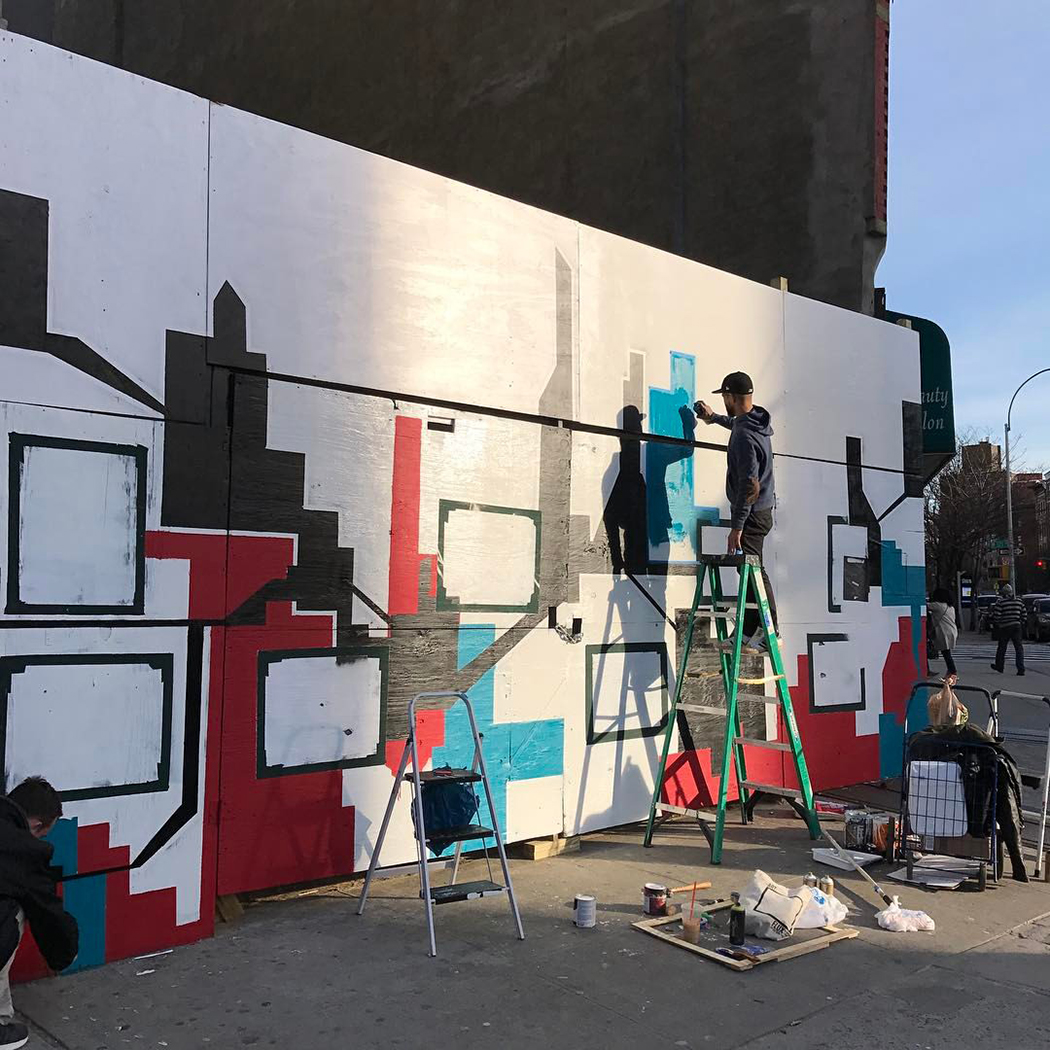
“I started Art In FLUX in the beginning of 2012 to put art in public places in Harlem by activating vacant retail locations and other underutilized spaces with art. It has expanded to include public art on the streets, in parks, schools and lobbies. Harlem and Upper Manhattan as a whole is underserved in respect to access to art. Art In FLUX puts art in places where everyone can see it and enjoy it. Most recently we erected a series of dioramas or 3-D windows on a construction site on a main boulevard (121st and Frederick Douglass Blvd) — up through end of May. It's exciting to see families, kids, and all ages stopping to enjoy these projects as they walk by during their daily life.”
Please Pick Project
From: Suzanne Barish
Location: Nyack, NY is our hometown. The project has spread to other towns in Rockland County and Northern NJ.
Project Link: Please Pick Project
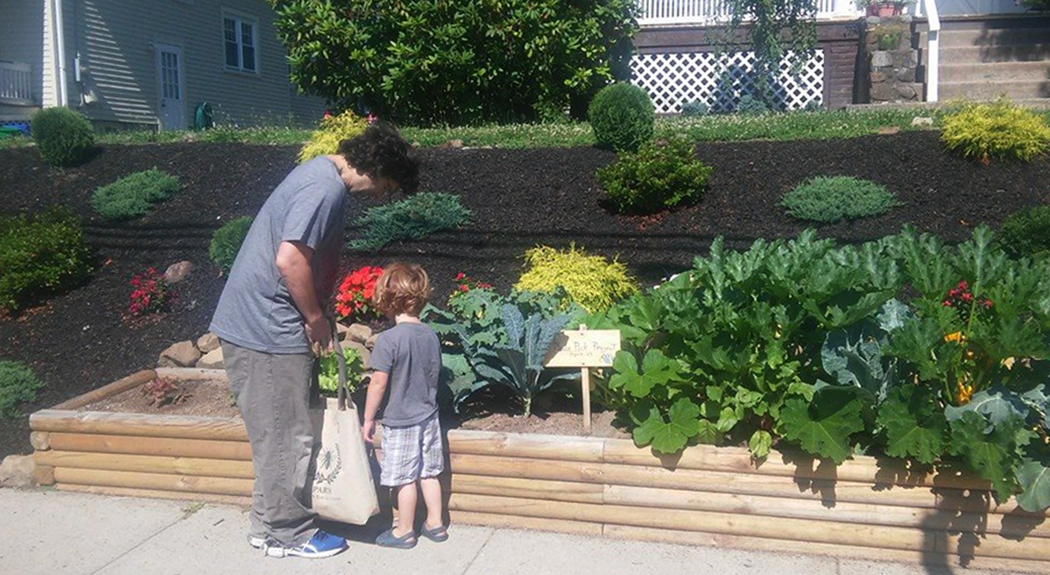
“It began with me making a somewhat crazy proposal to my neighbors to start growing food to share in our front yards. Please Pick Project is committed to making healthy food accessible to our community by weaving organic gardens into the urban and suburban landscape. The result is an edible village, replete with fruit trees and vegetable gardens growing within reach of the sidewalk in our walkable downtown area. And all people are invited to stop and pick the food for free whenever they please.
The impetus for starting this project was simply a moment when I was struck by two seemingly unrelated facts in our town. One, over 90 people per week rely on soup kitchens for their meals, and thousands more go hungry, are undernourished, don't have consistent access to healthy food, or are simply cut off from the real origins of their food. That food insecurity really affects all of us; and, two, we have a surplus of open space in front yards and on public land that can be growing food for all neighbors to share with one another.
Normalizing the idea of growing free organic food all around town took about a year of solid PR work. But now, three years later, Please Pick Project has become a respected community organization. Though the idea still strikes many as green anarchy, that phrase is now charged with positive, empowering energy rather than fear of unconventional food production.”
Mullaly Bikepark/BMX
From: Brendan Vail
Location: The Bronx
Project Link: Mullaly Bikepark/BMX
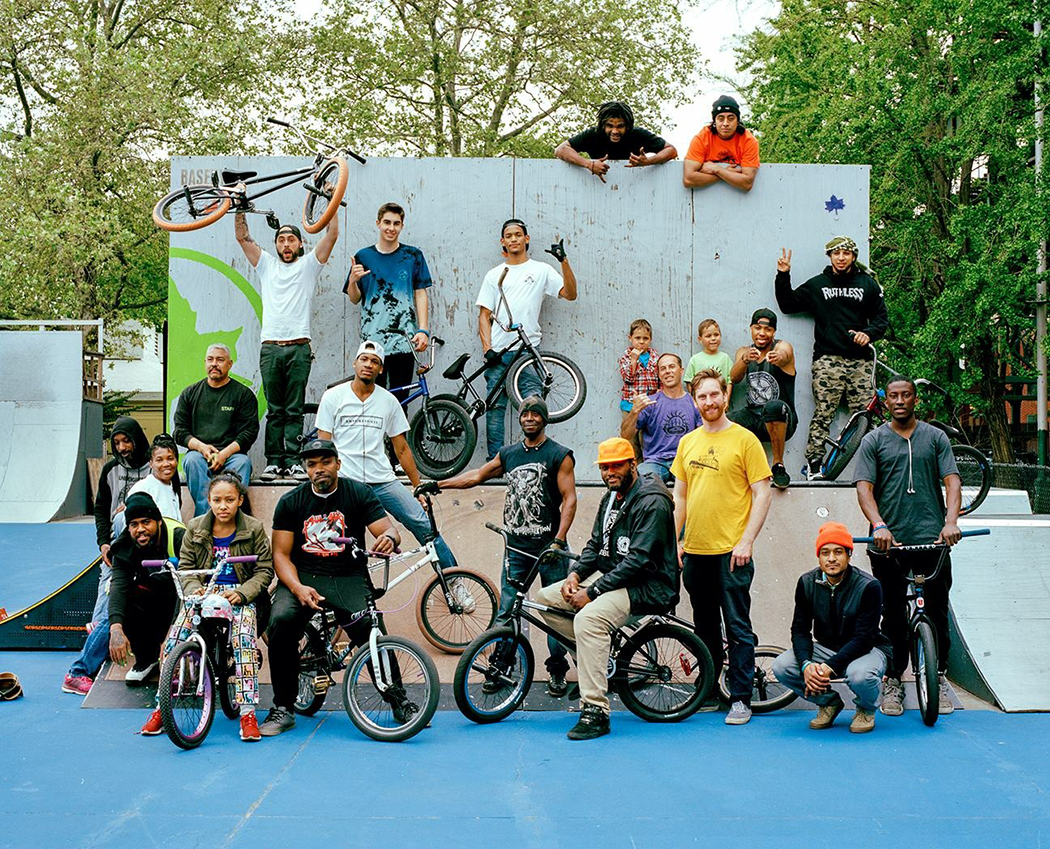
“My project is the revitalization of Mullaly Bikepark, NYC's first ramp park dating back to 1988, it was previously used as a skating rink. The project started when the park which sits behind Yankee Stadium in The Bronx fell into disrepair. My fellow BMX riders and myself took it upon ourselves to rebuild the park, and create a positive place for the youth of the community. We formed a non-profit, have applied to and received a number of grants and turned an underused bland space into a bright fun area full of color that hosts over 2,000 visitors per week in peak season. Without the work of our great team of volunteers and network of supportive people we would not have been able to accomplish all we have so far.”
The Art Explorers Club
From: Molly O’ Brien
Location: Brooklyn
Project Link: NURTUREart
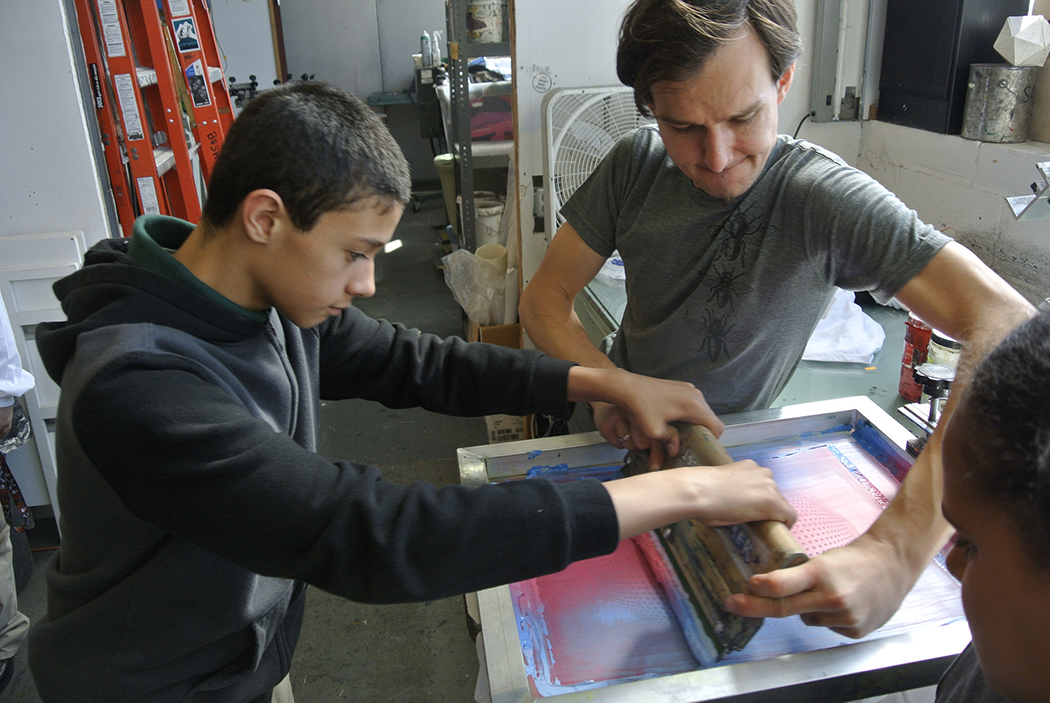
“The Art Explorers Club is an afterschool program for third grade students at P.S. 147 in Bushwick. We visit artist studios, galleries, and other creative spaces in the neighborhood. The intent of the Art Explorers Club is to teach art literacy while introducing the students to their neighbors and potential careers in the arts, creating a place for these communities to connect. The Art Explorers Club is run by NURTUREart, a non-profit gallery just a few blocks away from P.S. 147 in Bushwick.
P.S. 147 is located in the thriving arts community of Bushwick, yet the school doesn't have the resources for an art program or teacher. The neighborhood is quickly gentrifying. Through NURTUREart's Education Program, students from P.S. 147 visit the gallery to view our exhibitions throughout the year. I saw how the students developed a strong relationship with the space and staff, and realized that there are many (70+) other free art spaces that could be a resource to these students and their families. I first piloted this program in Spring of 2014, and the program continues to run every spring.”
Kids for a Better Future
From: Satya Viswanath Shaw
Location: Brooklyn and Citywide
Project Link: Kids for a Better Future (KBF)
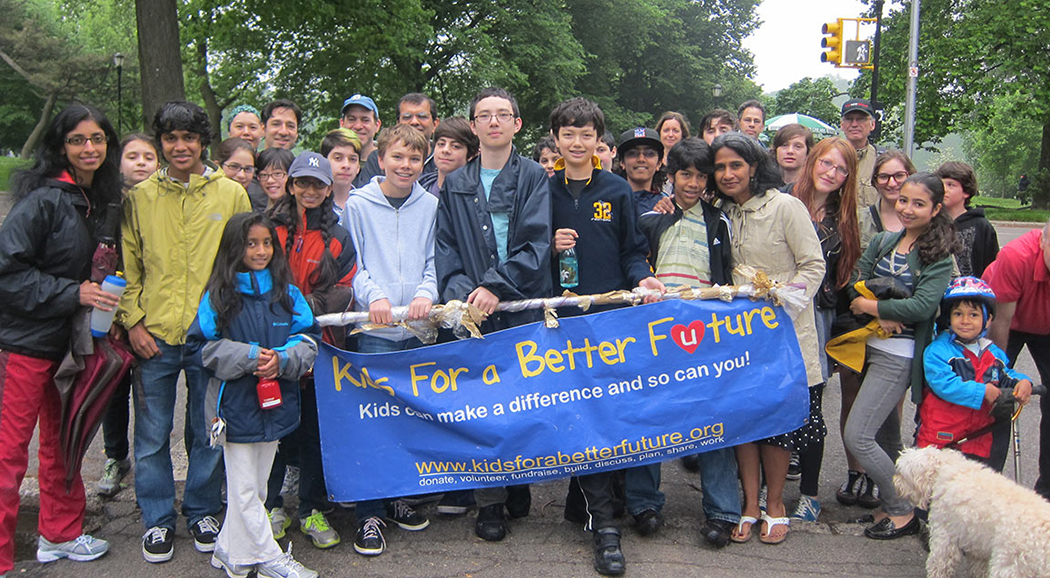
”Kids for a better future (KBF) is a kid run organization started by my brother when he was in third grade but now he is in college so I took over with my friends in fourth grade. Every year we support a different organization. This year, it’s the Coalition For The Homeless which is an organization that helps homeless people around New York. On May 6, 2017 KBF is having our tenth annual walkathon where we walk around Prospect Park and raise money for the organization that we're supporting.”
NOTE: These submissions have been edited for clarity.
